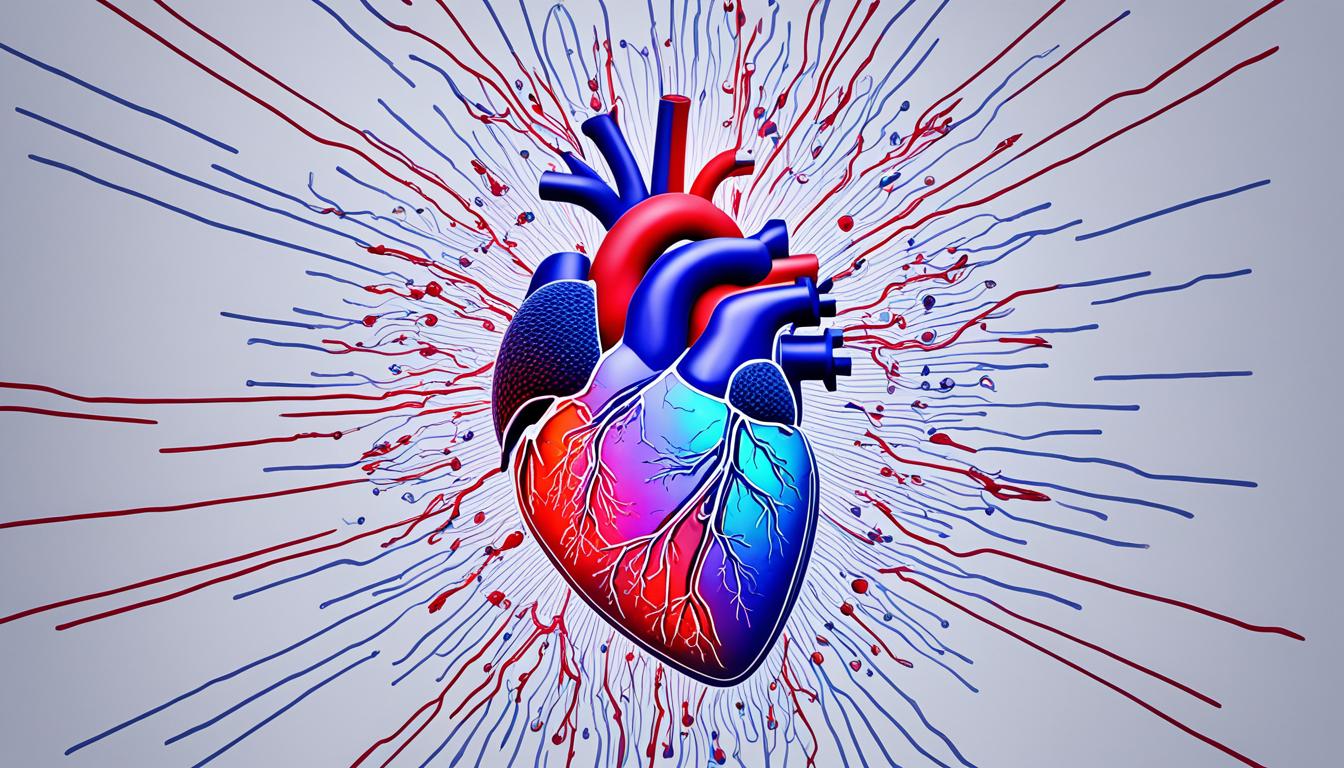Supraventricular tachycardia (SVT) is a health issue with a fast and irregular pulse. It mainly affects the top parts of the heart, the atria. This causes the heart’s rhythm to be off, leading to symptoms like a racing heart, feeling dizzy, hard to breathe, and chest pains. SVT can make it tough to live a full life.
Several things can trigger SVT. These include strange electrical routes in the heart, some health problems, certain drugs, and how we live. The abnormal paths interfere with the heart’s normal electrical signals. This leads to the atria beating too fast and out of sync with the heart.
Doctors look at your health history and check you out to diagnose SVT. They do tests like an electrocardiogram (ECG) and Holter monitoring. These tests show how the heart’s electricity is behaving and if there are any issues.
There are various ways to treat SVT. The method depends on the symptoms and the cause. Doctors might use drugs like beta-blockers or calcium channel blockers to slow the heart and get its rhythm back on track. In more severe cases, procedures like catheter ablation might be needed. This is where they fix the heart’s electrical paths to stop the issue.
Recently, researchers are looking into using stem cells to treat SVT. This cutting-edge method aims to fix the heart’s rhythm by improving its function. They are hopeful this new approach could be life-changing for people suffering from SVT.
Key Takeaways:
- SVT is a heart arrhythmia characterized by a rapid and irregular heartbeat, affecting the upper chambers of the heart.
- Common symptoms of SVT include heart palpitations, dizziness, shortness of breath, and chest discomfort.
- Causes of SVT can include abnormal electrical pathways in the heart, medical conditions, medications, and lifestyle factors.
- Diagnosis of SVT involves a medical history review, physical examination, and various tests, such as ECG and Holter monitoring.
- Treatment options for SVT range from medication to surgical procedures, depending on the severity and underlying cause.
- Stem cell therapy is an emerging treatment approach being researched to restore normal heart rhythm in patients with SVT.
Types of Supraventricular Arrhythmias
Supraventricular arrhythmias start in the heart’s upper chambers, the atria. They are different conditions with their own effects and risks.
Supraventricular Tachycardia (SVT)
Supraventricular tachycardia is a fast, regular heart rhythm issue. It is caused by the heart’s upper chambers beating too quickly because of unusual electrical signals.
Atrial Fibrillation
Atrial fibrillation is a prevalent arrhythmia with a quick, irregular heartbeat. The atria do not contract right, affecting blood flow and increasing stroke chances.
Wolff-Parkinson-White Syndrome
Wolff-Parkinson-White Syndrome is rare and involves extra pathways in the heart muscle. This can lead to fast heartbeats and a higher risk of arrhythmias.
Atrial Flutter
Atrial flutter makes the atria beat very fast but in a smooth manner. This can lead to heart symptoms like palpitations, breathlessness, and feeling lightheaded.
Premature Atrial Contractions (PACs)
Premature atrial contractions cause early heartbeats, disrupting the heart’s normal pace. They are often benign but might suggest heart problems needing attention.
Diagnosis and Treatment of SVT
SVT diagnosis is a detailed process. It aims to spot the cause and plan the right treatment. Doctors check the patient’s history and symptoms, do a physical exam, and run tests such as an ECG. Holter monitoring, stress tests, and echocardiograms are also key. They help find the SVT type and check for heart issues.
The treatment depends on how bad the symptoms are and what’s causing them. Doctors usually start with medicines like beta-blockers and calcium channel blockers. These drugs control the heart’s rhythm and can lower the number of SVT episodes. But if drugs don’t work, or you can’t take them, a procedure called ablation may be the next step. Ablation aims to fix the heart’s electrical signals, so it beats normally.
Stem cell therapy is also showing promise for SVT treatment. It’s being studied to see if stem cells can help the heart’s rhythm get back to normal. With this therapy, healthy stem cells are placed in the heart. This process helps renew heart tissue and boosts its electrical system. The early signs of this treatment look positive, but it’s still being researched.
If you notice fast beating, strong pulses, or chest pain, see a doctor right away. Getting diagnosed and treated early can make a big difference. It can help manage SVT better and improve how well you do in the long run.

